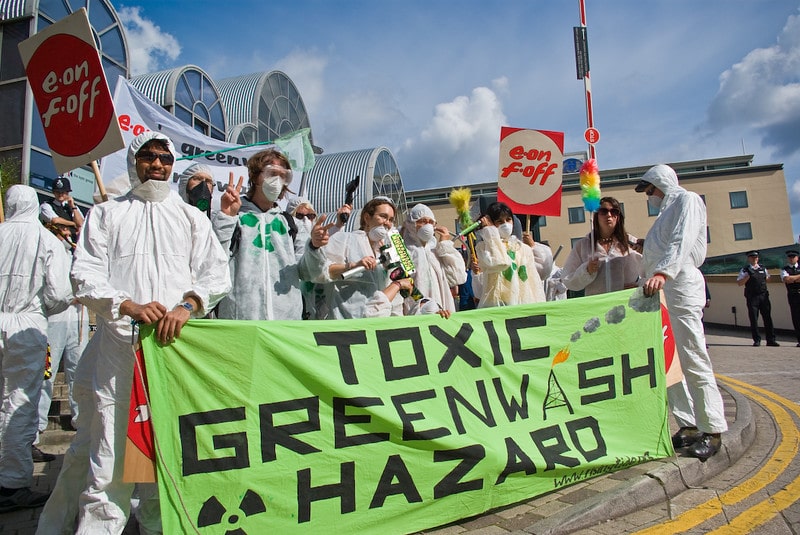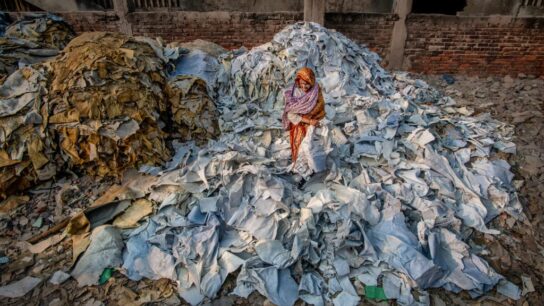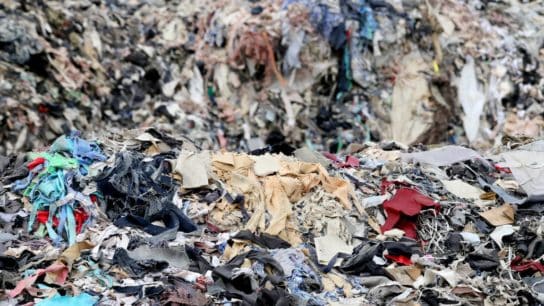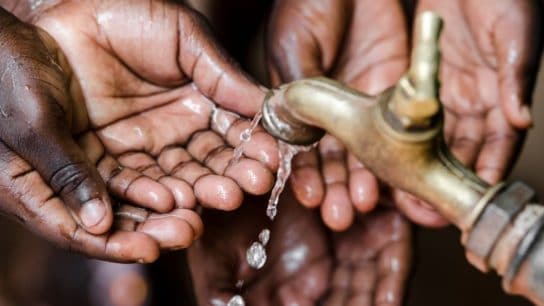Greenwashing can be as subtle as a misleading packaging choice all the way to fossil fuel companies touting themselves as being eco-champions. Either way, greenwashing is a harmful and deceitful way of advertising that a company is more sustainable than it actually is. Companies that make false claims should be held accountable. Here are 10 companies that have been caught greenwashing in various ways.
—
1. Volkswagen
A classic example of greenwashing is when Volkswagen admitted to cheating emissions tests by fitting various vehicles with a “defect” device, with software that could detect when it was undergoing an emissions test and altering the performance to reduce the emissions level.
This was going on while to the public the company was touting the low-emissions and eco-friendly features of its vehicles in marketing campaigns. In actuality, these engines were emitting up to 40 times the allowed limit for nitrogen oxide pollutants.
2. BP
Fossil fuel giant BP changed their name to Beyond Petroleum and publicly added solar panels on their gas stations. In December 2019, an environmental group called ClientEarth lodged a complaint against BP for misleading the public with its advertisements that focused on BP’s low-carbon energy products, when more than 96% of its annual spend is on oil and gas.
3. ExxonMobil
Oil giant ExxonMobil has a long history of damaging the environment. In 1989, an Exxon oil tanker spilled 11 million gallons of crude oil into Alaska’s Prince William Sound, in what was the worst oil spill in US history until the Deepwater Horizon oil spill in 2010. The Exxon oil spill covered 1,300 miles of coastline and killed hundreds of thousands of seabirds, otters, seals and whales. More than 30 years later, pockets of crude oil remain in some locations.
Recently, ExxonMobil came under fire for advertising that suggested that its experimental algae biofuels could one day reduce transport emissions, while it has no company-wide net zero target and its 2025 emission reduction targets do not include the vast majority of emissions resulting from its products.
4. Nestlé
In 2018, Nestlé released a statement saying that it had “ambitions” for its packaging to be 100% recyclable or reusable by 2025. However, environmental groups and other critics pointed out that the company hadn’t released clear targets, a timeline to accompany its ambitions or additional efforts to help facilitate recycling by consumers. Greenpeace reacted to this by releasing its own statement, in which it said, “Nestlé’s statement on plastic packaging includes more of the same greenwashing baby steps to tackle a crisis it helped to create. It will not actually move the needle toward the reduction of single-use plastics in a meaningful way, and sets an incredibly low standard as the largest food and beverage company in the world.” In Break Free From Plastic’s 2020 annual report, Nestlé, along with Coca-Cola and PepsiCo, were named the world’s top plastic polluters for the third year in a row.
5. Coca-Cola
In the annual report mentioned above by Break Free From Plastic, Coca-Cola was ranked as the world’s number 1 plastic polluter, it’s second consecutive year at the top. In 2020, the company came under fire when it announced that it would not abandon plastic bottles, saying that they were popular with customers.
Despite this, the company is adamant that it is making progress in tackling packaging waste. At the time, a spokesperson said, “Globally, we have a commitment to get every bottle back by 2030, so that none of it ends up as litter or in the oceans, and the plastic can be recycled into new bottles. Bottles with 100% recycled plastic are now available in 18 markets around the world, and this is continually growing.”
Then, in June 2021, environmental organisation Earth Island Institute filed a lawsuit against the beverage giant for falsely advertising that it is sustainable and eco-friendly despite being the largest plastic polluter in the world.
You might also like: Greenwashing: What is it, Why is it a Problem, and How to Avoid It
6. Starbucks
In 2018, Starbucks released a “straw-less lid,” as part of its sustainability drive, however this lid contained more plastic than the old lid and straw combination. The company didn’t dispute this, but claimed that it is made from polypropylene, a commonly-accepted recyclable plastic that “can be captured in recycling infrastructure.” Critics were quick to point out that only 9% of the world’s plastic is recycled, so the company shouldn’t assume all the lids would be recycled. Further, the US exports about one-third of its recycling to developing countries, so it is simply passing its responsibility to poorer countries.
7. IKEA
IKEA was considered a beacon of a major corporation being sustainable before June 2020 when the furniture retailer was linked with illegal logging in Ukraine. In a report by NGO Earthsight, the wood certification scheme IKEA uses, Forest Stewardship Council, was described as an organisation that greenwashes the timber industry. It was accused of failing to catch IKEA’s sourcing of conflict wood, and act on it.
Further, when IKEA built its “most sustainable store” yet in London in 2019, it did so on top of another sustainable store that was demolished after just 17 years of use.
8. Plastic Bottle Water Companies
A more subtle form of greenwashing can be seen in plastic water bottle companies like Poland Spring, Evian and Deer Park, that all have nature on their labels. This is laughably ironic considering that plastic water bottles are designed to be single-use and are contributing to the massive plastic waste crisis around the world.
You might also like: Top Sustainable Food Packaging Companies to Support
9. Major Banks
The past several years have seen major financial institutions talking a big game about combating climate change yet these are more examples of companies exercising greenwashing strategies. JP Morgan, Citibank and Bank of America have issued new “green investment” opportunities. However, a report released last year by the Rainforest Action Network showed that big banks – the ones mentioned above, but also including Wells Fargo, Barclays, Bank of China, HSBC, Goldman Sachs and Deutsche Bank – were still lending enormous sums to the industries that contribute the most to global warming, like fossil fuels and deforestations, while boasting that they’re the leaders of the green transition.
10. Fast Fashion Brands
H&M, Zara and Uniqlo are among the companies that were caught greenwashing over the years. These fashion brands contribute to the massive amounts of textile waste caused by the clothing industry. According to the fashion nonprofit ReMake, 80% of discarded textiles globally are incinerated or landfill-bound, with just 20% being reused or recycled.
Fast fashion brands also have a habit of advertising its green initiatives widely, despite it being a tiny part of its operations. For example, in 2019, H&M launched its own line of “green” clothing titled “Conscious.” The company claims to use “organic” cotton and recycled polyester. However, the line is nothing but a marketing tactic used to make themselves appear more environmentally friendly. When looking at H&M’s “Conscious” line, its mission states: “Shop our selection of sustainable fashion pieces that make you both look and feel good.” However, there is no single legal definition for marketing-friendly words such as “sustainable,” “green,” or “environmentally-friendly.” H&M was then criticised by the Norwegian Customer Authority for “misleading” marketing of their Conscious Collection because “the information given regarding sustainability was not sufficient, especially given that the Conscious Collection is advertised as a collection with environmental benefits.”
You might also like: 16 Most Sustainable Fashion Brands to Support
How can I contribute to a more sustainable planet?
- 🗳️ Vote for Climate Action: Exercise your democratic rights by supporting candidates and policies that prioritize climate change mitigation and environmental protection. Stay informed with Earth.Org’s election coverage.
- 👣 Reduce Your Carbon Footprint: Make conscious choices to reduce your carbon footprint. Opt for renewable energy sources, conserve energy at home, use public transportation or carpool, and embrace sustainable practices like recycling and composting.
- 💰 Support Environmental Organizations: Join forces with organizations like Earth.Org and its NGO partners, dedicated to educating the public on environmental issues and solutions, supporting conservation efforts, holding those responsible accountable, and advocating for effective environmental solutions. Your support can amplify their efforts and drive positive change.
- 🌱 Embrace Sustainable Habits: Make sustainable choices in your everyday life. Reduce single-use plastics, choose eco-friendly products, prioritize a plant-based diet and reduce meat consumption, and opt for sustainable fashion and transportation. Small changes can have a big impact.
- 💬 Be Vocal, Engage and Educate Others: Spread awareness about the climate crisis and the importance of environmental stewardship. Engage in conversations, share information, and inspire others to take action. Together, we can create a global movement for a sustainable future.
- 🪧 Stand with Climate Activists: Show your support for activists on the frontlines of climate action. Attend peaceful protests, rallies, and marches, or join online campaigns to raise awareness and demand policy changes. By amplifying their voices, you contribute to building a stronger movement for climate justice and a sustainable future.
For more actionable steps, visit our ‘What Can I do?‘ page.
This story is funded by readers like you
Our non-profit newsroom provides climate coverage free of charge and advertising. Your one-off or monthly donations play a crucial role in supporting our operations, expanding our reach, and maintaining our editorial independence.
About EO | Mission Statement | Impact & Reach | Write for us













